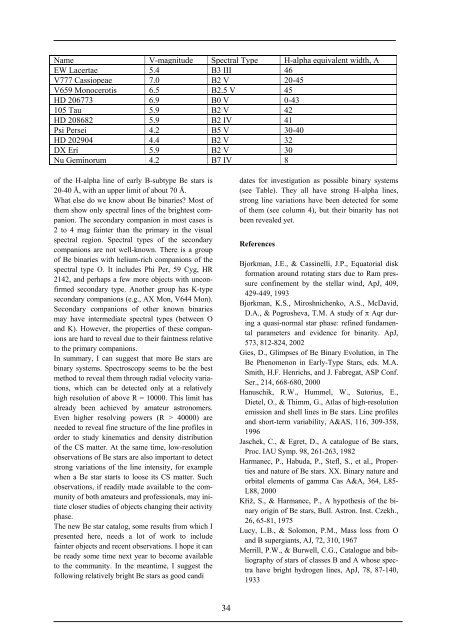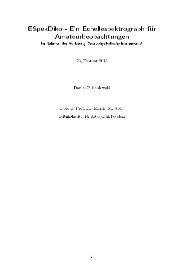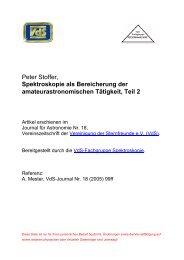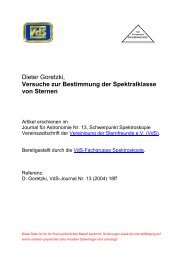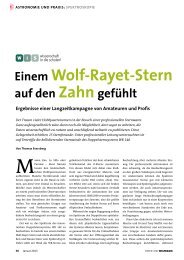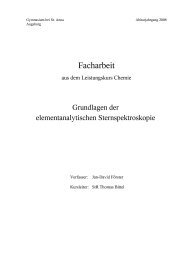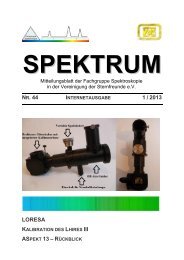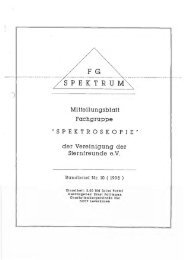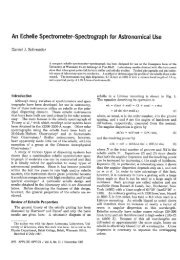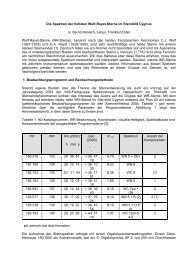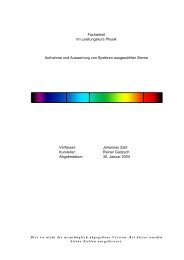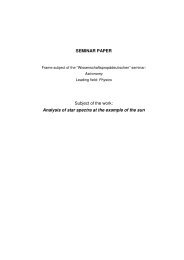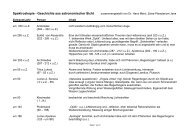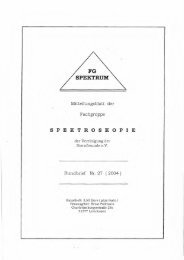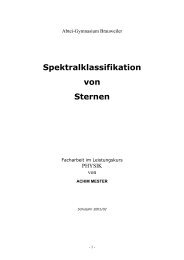Tagungsbericht der VdS-Fachgruppe SPEKTROSKOPIE
Tagungsbericht der VdS-Fachgruppe SPEKTROSKOPIE
Tagungsbericht der VdS-Fachgruppe SPEKTROSKOPIE
Erfolgreiche ePaper selbst erstellen
Machen Sie aus Ihren PDF Publikationen ein blätterbares Flipbook mit unserer einzigartigen Google optimierten e-Paper Software.
Name V-magnitude Spectral Type H-alpha equivalent width, A<br />
EW Lacertae 5.4 B3 III 46<br />
V777 Cassiopeae 7.0 B2 V 20-45<br />
V659 Monocerotis 6.5 B2.5 V 45<br />
HD 206773 6.9 B0 V 0-43<br />
105 Tau 5.9 B2 V 42<br />
HD 208682 5.9 B2 IV 41<br />
Psi Persei 4.2 B5 V 30-40<br />
HD 202904 4.4 B2 V 32<br />
DX Eri 5.9 B2 V 30<br />
Nu Geminorum 4.2 B7 IV 8<br />
of the H-alpha line of early B-subtype Be stars is<br />
20-40 Å, with an upper limit of about 70 Å.<br />
What else do we know about Be binaries? Most of<br />
them show only spectral lines of the brightest companion.<br />
The secondary companion in most cases is<br />
2 to 4 mag fainter than the primary in the visual<br />
spectral region. Spectral types of the secondary<br />
companions are not well-known. There is a group<br />
of Be binaries with helium-rich companions of the<br />
spectral type O. It includes Phi Per, 59 Cyg, HR<br />
2142, and perhaps a few more objects with unconfirmed<br />
secondary type. Another group has K-type<br />
secondary companions (e.g., AX Mon, V644 Mon).<br />
Secondary companions of other known binaries<br />
may have intermediate spectral types (between O<br />
and K). However, the properties of these companions<br />
are hard to reveal due to their faintness relative<br />
to the primary companions.<br />
In summary, I can suggest that more Be stars are<br />
binary systems. Spectroscopy seems to be the best<br />
method to reveal them through radial velocity variations,<br />
which can be detected only at a relatively<br />
high resolution of above R = 10000. This limit has<br />
already been achieved by amateur astronomers.<br />
Even higher resolving powers (R > 40000) are<br />
needed to reveal fine structure of the line profiles in<br />
or<strong>der</strong> to study kinematics and density distribution<br />
of the CS matter. At the same time, low-resolution<br />
observations of Be stars are also important to detect<br />
strong variations of the line intensity, for example<br />
when a Be star starts to loose its CS matter. Such<br />
observations, if readily made available to the community<br />
of both amateurs and professionals, may initiate<br />
closer studies of objects changing their activity<br />
phase.<br />
The new Be star catalog, some results from which I<br />
presented here, needs a lot of work to include<br />
fainter objects and recent observations. I hope it can<br />
be ready some time next year to become available<br />
to the community. In the meantime, I suggest the<br />
following relatively bright Be stars as good candi<br />
34<br />
dates for investigation as possible binary systems<br />
(see Table). They all have strong H-alpha lines,<br />
strong line variations have been detected for some<br />
of them (see column 4), but their binarity has not<br />
been revealed yet.<br />
References<br />
Bjorkman, J.E., & Cassinelli, J.P., Equatorial disk<br />
formation around rotating stars due to Ram pressure<br />
confinement by the stellar wind, ApJ, 409,<br />
429-449, 1993<br />
Bjorkman, K.S., Miroshnichenko, A.S., McDavid,<br />
D.A., & Pogrosheva, T.M. A study of � Aqr during<br />
a quasi-normal star phase: refined fundamental<br />
parameters and evidence for binarity. ApJ,<br />
573, 812-824, 2002<br />
Gies, D., Glimpses of Be Binary Evolution, in The<br />
Be Phenomenon in Early-Type Stars, eds. M.A.<br />
Smith, H.F. Henrichs, and J. Fabregat, ASP Conf.<br />
Ser., 214, 668-680, 2000<br />
Hanuschik, R.W., Hummel, W., Sutorius, E.,<br />
Dietel, O., & Thimm, G., Atlas of high-resolution<br />
emission and shell lines in Be stars. Line profiles<br />
and short-term variability, A&AS, 116, 309-358,<br />
1996<br />
Jaschek, C., & Egret, D., A catalogue of Be stars,<br />
Proc. IAU Symp. 98, 261-263, 1982<br />
Harmanec, P., Habuda, P., Stefl, S., et al., Properties<br />
and nature of Be stars. XX. Binary nature and<br />
orbital elements of gamma Cas A&A, 364, L85-<br />
L88, 2000<br />
Křiž, S., & Harmanec, P., A hypothesis of the binary<br />
origin of Be stars, Bull. Astron. Inst. Czekh.,<br />
26, 65-81, 1975<br />
Lucy, L.B., & Solomon, P.M., Mass loss from O<br />
and B supergiants, AJ, 72, 310, 1967<br />
Merrill, P.W., & Burwell, C.G., Catalogue and bibliography<br />
of stars of classes B and A whose spectra<br />
have bright hydrogen lines, ApJ, 78, 87-140,<br />
1933


